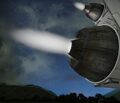Atmospheric Thrusters
Atmospheric Thrusters are, as their names indicate, thrusters that operate only on planets with atmospheres.
 Atmospheric Thruster
Atmospheric Thruster
 Large Atmospheric Thruster
Large Atmospheric Thruster
 Flat Atmospheric Thruster
Flat Atmospheric Thruster
 Large Flat Atmospheric Thruster
Large Flat Atmospheric Thruster
Usage
Atmospheric thrusters can be used on all planets with thick enough atmospheres. On planets, make your strongest atmo thrusters the dorsal thrusters, they point downwards to counter gravity. If you choose to include them on a shuttle, switch them off when you reach space to save power. They are the most efficient source of thrust in an atmosphere, better than hydrogen thrusters.
Another advantage is low cost, they do not require expensive ![]() Thruster Components, and you can build their components with basic resources found on planets. Their main disadvantage is the futility of using them in space, on moons, and asteroids. While transitioning to space, they slowly lose all thrust.
Thruster Components, and you can build their components with basic resources found on planets. Their main disadvantage is the futility of using them in space, on moons, and asteroids. While transitioning to space, they slowly lose all thrust.
Construction
If you have Progression on, you must build a cockpit or Remote Control first to unlock atmospheric thrusters.
Gallery
Considerations
| Ship Type | Block Type | Dimensions
(blocks) |
Thrust
(kN)[note 1] |
Max Power Requirements
(MW)[note 2] |
Power Efficiency
(kN/MW) |
Volume Efficiency
(kN/block) |
Exhaust Destruction
(blocks)[note 3] |
|---|---|---|---|---|---|---|---|
| Large Grid | 5x3x3 | 6480 | 16.80 | 385.71 | 144.00 | 3x1x1 | |
| 3x1x1 | 648 | 2.40 | 270.00 | 216.00 | 1x1x1 | ||
| 2x3x3 | 2600 | 6.70 | 388.06 | 144.44 | 1x1x1 | ||
| 1x1x1 | 200 | 0.80 | 250.00 | 200.00 | 1x1x1 | ||
| Small Grid | 5x3x3 | 576 | 2.40 | 240.00 | 12.80 | 4x1x1 | |
| 3x1x1 | 96 | 0.60 | 160.00 | 32.00 | 1x1x1 | ||
| 2x3x3 | 230 | 1.00 | 230.00 | 12.78 | 1x1x1 | ||
| 1x1x1 | 32 | 0.20 | 160.00 | 32.00 | 1x1x1 |
- ↑ The Thrust Values are based at the override function of the Thruster and what is displayed there.
- ↑ The "Max Required Input" shown in the for the block in the console screen.
- ↑ The Exhaust Destruction "Hit-Box" describes the region in which Blocks are damaged. (Tested by placing unbuilt light armor blocks in front of thrusters with maximum thrust override).
Note that the 5x3x3 ![]() Large Atmospheric Thrusters are more power efficient than the 3x1x1
Large Atmospheric Thrusters are more power efficient than the 3x1x1 ![]() Atmospheric Thrusters, but are less space efficient as they produce less thrust per block. Therefore, the latter might be more suitable for mining ships that need to carry heavy loads through tight tunnels, while the former might be more suitable for cargo ships that need to carry heavy loads across long distances.
Atmospheric Thrusters, but are less space efficient as they produce less thrust per block. Therefore, the latter might be more suitable for mining ships that need to carry heavy loads through tight tunnels, while the former might be more suitable for cargo ships that need to carry heavy loads across long distances.
Horizontal Flight
Some tips for a horizontal long distance flight on a planet:
- Create a separate control group for your braking thrusters (the fore thrusters) and add the group’s on/off action to your Tool Bar.
- While flying horizontally, keep Inertial Dampers on to fight gravity. Toggle off your braking thrusters to save power.
- To brake, keep Inertial Dampers on and toggle your braking thrusters back on.
Vertical Flight
Some tips for an atmospheric shuttle lifting off vertically from a planet into “orbit”:
- Make sure you have additional Ion or Hydrogen thrusters installed to take over as soon as you reach space!
- Create separate control groups for the different types of thrusters so you can switch them all on or all off.
- Create a separate control group for the atmospheric thrusters that counter gravity in a vertical lift-off.
- Add the Increase and Decrease Thrust Override actions for your lift-off thruster group to your Tool Bar.
- After lift-off, increase the Thrust Override until you reach a stable maximum acceleration (99m/s), then switch off Inertial Dampers to save power until you reach “orbit”.
- When leaving the atmosphere, switch on your Hydrogen/Ion thrusters, reset the thrust override, and switch off the Atmospheric Thrusters.
Switch Inertial Dampers back on while manoeuvring.
See Also



